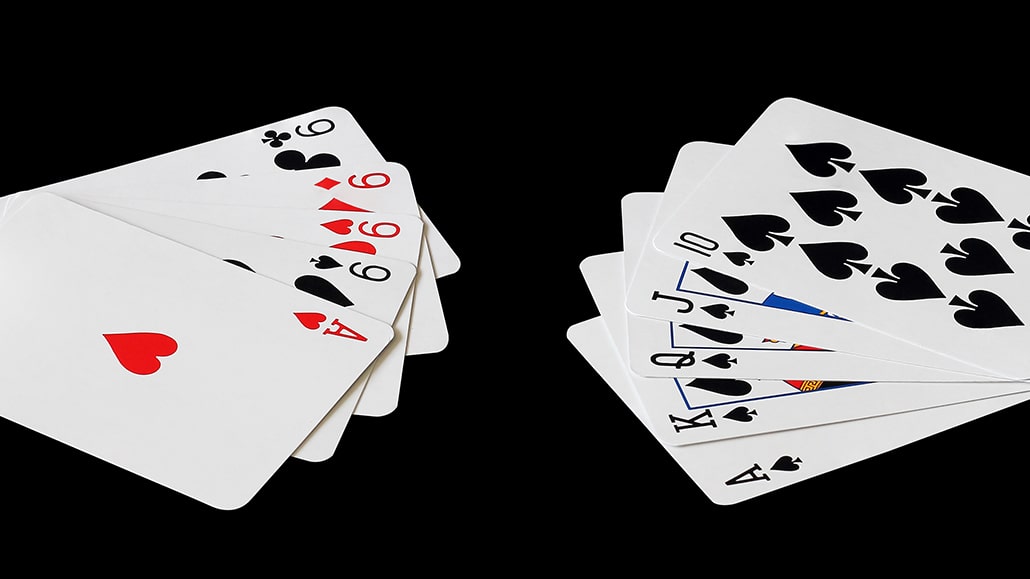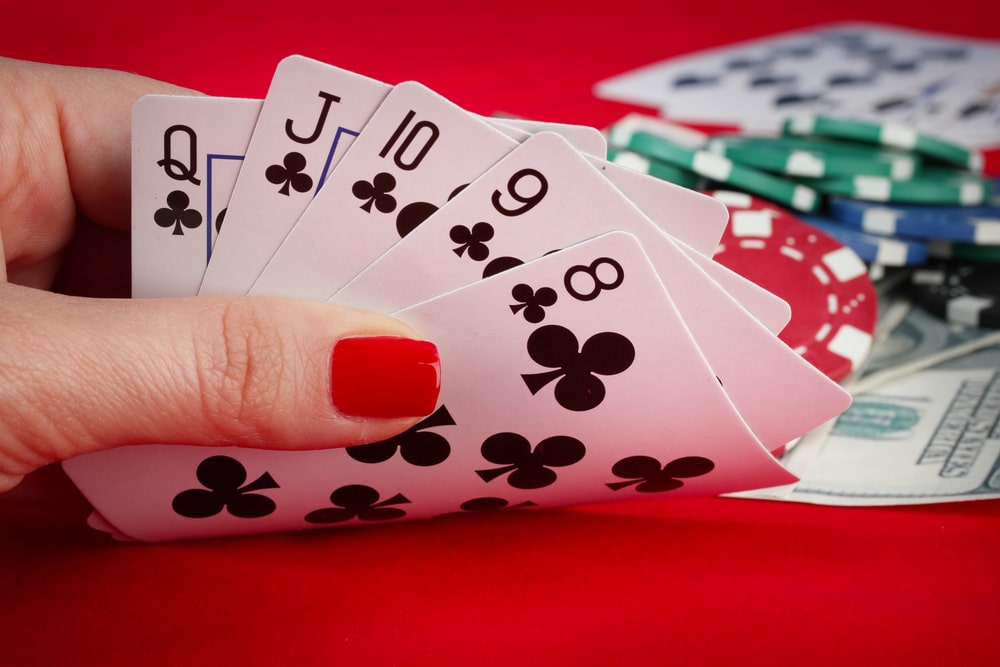Does A Full House Beat A Flush In Poker & Why?

The game of poker can be confusing in the beginning, not only do you need to think about which cards you are holding, but you also consider what your opponent has. On top of that, there is still the question of whether you beat your opponent’s hand in the first place
A common confusion between players comes in trying to answer a simple question – does a full house beat a flush?
The short answer is YES, a full house does beat a flush.
That said, we decided to dig deeper into the math behind these combinations and teach you the full house vs flush odds and probabilities that you can apply for other hand combinations.
Does A Full House Beat A Flush In Poker?

Yes, as we mentioned before, a full house beats a flush in Texas Holdem poker. If we take a look at this table with the hand rankings in Texas Holdem, we can see that the number of available combinations measures the strength of a hand in poker.
| Hand | Combinations | Probability | Odds |
| Royal Flush | 4 | 0.000154% | 649,739-to-1 |
| Straight Flush | 36 | 0.00139% | 72,192-to-1 |
| Four of a Kind | 624 | 0.02401% | 4,164-to-1 |
| Full House | 3,744 | 0.1441% | 693-to-1 |
| Flush | 5,108 | 0.1965% | 509-to-1 |
| Straight | 10,200 | 0.3925% | 254-to-1 |
| Three of a Kind | 54,912 | 2.1128% | 46-to-1 |
| Two Pair | 123,552 | 4.7539% | 20-to-1 |
| One Pair | 1,098,240 | 42.2569% | 1.37-to-1 |
The royal flush is the strongest hand in Texas Holdem poker because there are only four possible combinations of this hand, less than any other.
On the other hand, one pair is the weakest paired hand in poker as there are 1,098,240 possible combinations of this hand.
We can apply the same rules and principles to answer the full house vs flush question.
There are 5108 possible flush combinations and 3744 possible full house combinations in poker.
This means that, in Texas Holdem, there is a 3.03% chance that you will make a flush using all five community cards.
The chances of combining all five community cards with your hole cards to get a full house are slightly less, around 2.6%.
Full house combinations occur less frequently than flush combinations, which is why a full house beats a flush in Texas Holdem games.
Remember, this only applies to the full house vs “ordinary” flush. If you want to know does a full house beat a straight flush, we have prepared an answer in the text below, but you get the idea.
This is why it is important to know poker odds, cause you can clearly see it can give you answers to many common questions.
What Is A Flush In Poker?

In most poker variants, like the Texas Holdem or the 5-card draw, the flush represents a five-card combination that contains all five cards of the same suit that are not sequential.
Here are two examples of flush combinations.
- A♣10♣8♣5♣4♣
- Q♦J♦9♦7♦6♦
If all of the cards in the combination are the same suits and sequential, that hand combination is called a straight flush.
Here are two examples of straight flush combinations.
- Q♠J♠10♠9♠8♠
- 6♣5♣4♣3♣2♣
The rarest type of flush in poker is the royal flush. A royal flush hand consists of five sequential cards of the same suit where the highest card is the ace, and the lowest card is the ten.
Here are two examples of royal flush combinations.
- A♠K♠Q♠J♠10♠
- A♥K♥Q♥J♥10♥
Although the flush, the straight flush, and the royal flush all consist of five cards of the same suit, they are all ranked differently because each of these hands has a different number of possible combinations.
The Number of Flush Combinations In Texas Holdem
The standard 52-card deck contains four different suits (hearts, diamonds, spades, and clubs), and there are thirteen cards for each suit (A, K, Q, J, T, 9, 8, 7, 6, 5, 4, 3, 2) which means that there are:
- 5108 possible five-card flush combinations
- 36 possible five-card straight flush combinations (9 for each suit)
- 4 possible royal flush combinations (1 for each suit)
Accordingly, the strongest flush and the strongest hand overall in Texas Holdem is the royal flush, and the second strongest flush in poker is the straight flush.
Finally, the “ordinary” flush is the weakest flush and the 5th strongest hand in Texas Holdem poker.
Now, let us take a closer look at the full house combination in Texas Holdem poker.
What Is A Full House In Poker?

In poker, a full house is a five-card combination containing three cards of one rank and two cards of another. A combination of trips and a pair.
The full house can also be referred to as a full boat or a boat.
Here are two examples of a full house.
- 7♠7♣7♦A♣A♦
- A♣A♦A♥7♣7♦
The first full house combination is called “sevens full of aces,” and the second combination is called “aces full of sevens.”
All full house combinations are ranked based on:
- The rank of the trips
- The rank of the pair
This is why these two combinations, although they look similar, have different names and are ranked differently.
In this case, the second combination (aces full of sevens) outranks the first combination (sevens full of aces) because the trips in the first hand (three aces) are stronger than the trips in the second hand (three sevens).
Players new to poker often get confused and think that the full house with the higher cards is stronger but fail to realize that they first need to look at the rank of the trips and then the rank of the pair.
For example
5♠5♦5♣2♣2♦ is stronger than 4♠4♣4♦A♥A♠.
Only in cases where the trips are of the same rank does the rank of the pair comes into play.
This can happen specifically in hands where both players use the same community cards to complete their house combinations.
For example
Player 1 holds A♣8♣
Player 2 holds A♦5♦
And the board is A♥A♠8♠5♥K♣
In this situation:
Player 1 holds: A♣A♥A♠8♣8♠ – full house aces full of eights
Player 2 holds: A♦A♥A♠5♦5♥ – full house aces full of fives
Because both players have trips of the same rank, to decide which full house is stronger, we need to look at the rank of the pair.
Player 1 has a pair of eights, and Player 2 holds a pair of fives which means that Player 1 is holding a stronger full house combination because a pair of eight beats a pair of fives in Texas Holdem.
The Number of Full House Combinations In Texas Holdem
There are 3744 possible full house hand combinations in a 52-card deck with 156 different ranks of this combination.
The full house, we used an example in the text above, 7 7 7 A A is just one rank of this combination. If we consider suits, we can calculate that there are two dozen ways to create each individual full house. For example:
- 7♠7♥7♦A♣A♦
- 7♠7♥7♠A♣A♦
- 7♠7♥7♣A♥A♦, etc.
If we multiply the number of different ranks (156) by the number of each individual full house (24), we get the total number of full house combinations (3744).
Does a Full House Beat a Straight Flush

First, let us give you the short answer, a full house does not beat a straight flush in poker.
Now, like in the “does a full house beat a flush” example, we will look at some of the numbers.
So for the full house, we already know that there are 3744 possible full house combinations, and in the first part of the text, we calculated that there are 36 possible combinations of a straight flush.
Chances of getting a straight flush in Texas Holdem are 72,192 to 1 or 0.0279%.
If we compare this to the 2.6% chance of getting a full house, we can see a much higher possibility of having a full house than a straight flush.
We already know that the lower the chances of getting a hand in Texas Holdem poker, the stronger the hand.
In this case, a full house does not beat a straight flush as there are many more combinations of full houses available than straight flushes.
This is the case in both live and online poker games, so make sure to know your numbers before you sit down to play.
- Heartland Poker Tour – Will HPT Ever Come Back - October 20, 2022
- Top 6 Pros of Playing Slots Online - October 13, 2022
- Sammy Farha Net Worth – How Wealthy Is the Poker Icon? - October 13, 2022





